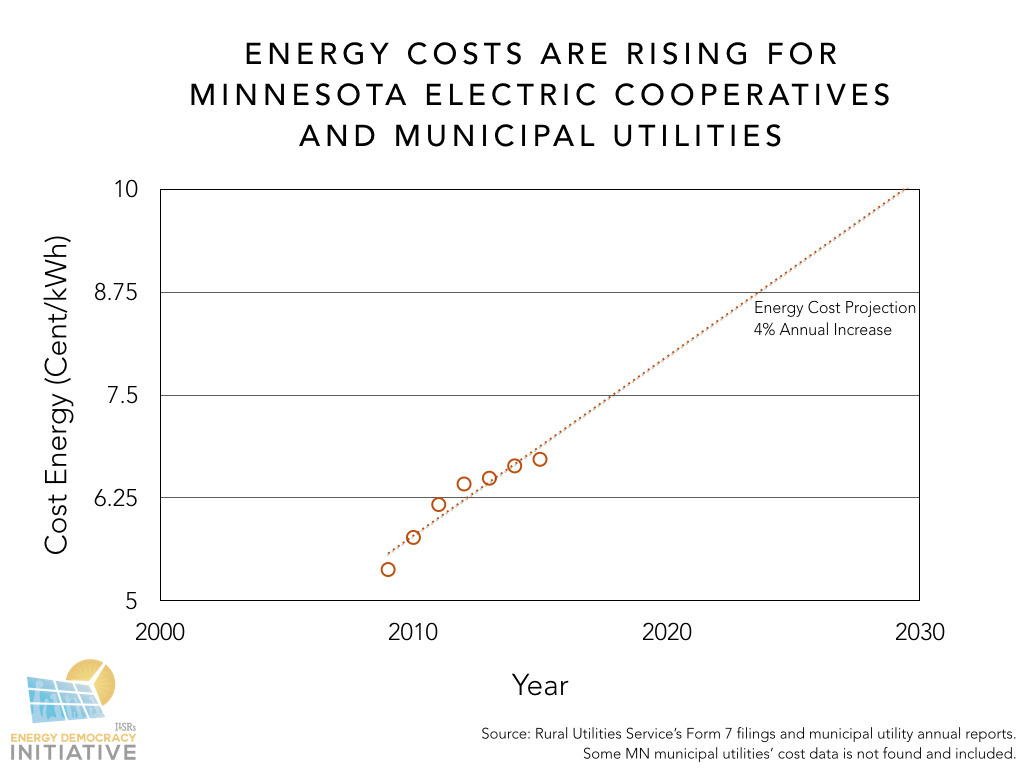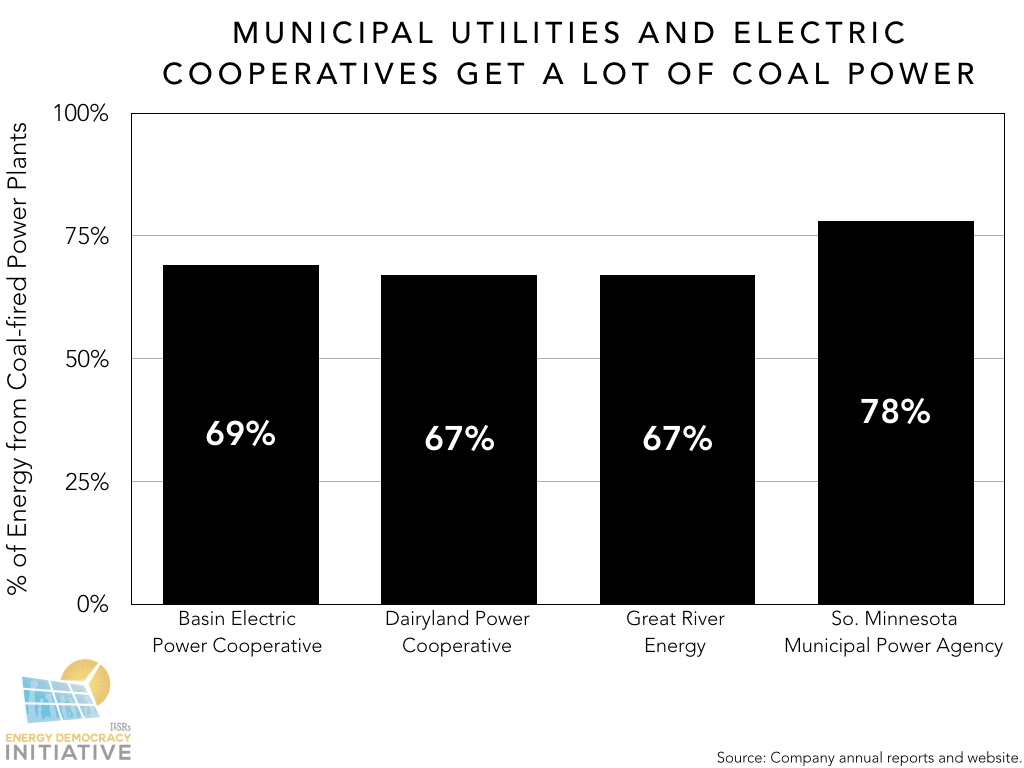This post made possible by the tireless efforts of ILSR intern Abbigail Feola. She dug up the data, identified the story worth sharing, and wrote the following piece below.
Historically, the purpose of both municipal and cooperative utility agencies has been to bring energy services to communities that for-profit corporations thought unprofitable to serve. This philosophy of self-reliance shifted the focus from profit margins towards social goods, and persists today. Municipal utilities are owned by and located in the cities they serve; their primary interest is not the welfare of their investors, but of their city or town. Likewise, cooperatives are owned and run by their members, people with strong social, environmental, financial, and cultural stakes in the activities of the cooperative.
But the ways in which municipal and cooperative utilities procure power undermine this ethic of community service and self-reliance.
Most municipal utilities have long-term contracts to purchase power from joint action agencies, and cooperative utilities from generation and transmission cooperatives. Utilities pursue these long-term contracts to obtain favorable interest rates and credit ratings from the finance industry. Even the National Rural Electric Cooperative Association states, “Since the wholesale power contract serves as the basic foundation for G&T [generation and transmission cooperative] financing, and since a multiplicity of stakeholders (such as lenders, regulators, or trustees, for example) have approval rights on any modifications to the contracts, it is nearly impossible to side-step the provisions of all-requirements wholesale power contracts in accessing and using power from sources other than the G&T.” In other words, financiers give better deals for financing big, new power plants when the local utilities are legally obligated to buy the power on a very long-term contract.
The more restrictive and longer the term, the less costly it will be to fund energy infrastructure. But the result of this system is a major restriction of utilities’ abilities to operate flexibly and independently. In many cases, small, local utilities are tied into contracts for increasingly-expensive fossil-fuel power for decades, even when they may have options to procure local, renewable electricity at low cost, or with additional local economic benefits.
The loss of local authority, flexibility, and freedom can be solved in whole or part by shifting decision-making authority back to the local level, including expanding options for self-supply.
To understand the current state of the industry and how it could be changed, ILSR contacted various cooperative and municipal utilities, the latter under the Data Practices Act, to collect information on their contract lengths and the costs of electricity paid by utilities. The findings show that decades-long contracts and past and current heavy investments in dirty energy are dramatically limiting utilities’ use of cost-efficient and environment-friendly power sources.
Unwise Investments
The electric industry has always made enormous investments, in the billions of dollars, to generate and transmit electricity. Rising investments in transmission and distribution technology, among other factors, have contributed to rising electricity costs. Prior to the last 10 years, rising energy demand allowed utilities to spread these costs over greater sales.
But in the past decade, costs have risen while general demand for electricity (measured in kilowatt-hours, or kWh) has been either unchanging or declining.
The result is higher costs for consumers. For example, Great River Energy, one of Minnesota’s largest generation and transmission cooperatives, made massive investments in coal plants over the past decade, resulting in rising electric costs. (x)These include nearly 500 million dollars spent constructing the Spiritwood coal-fired plant, which was shut down due to lack of demand. The Southern Minnesota Municipal Power Agency has a similar cost problem. Due to the low costs of wind and natural gas power and the inflexible operating system of its coal plant Sherco 3, according to its 2015 annual report, it is having difficulty recovering the costs of operating the coal plant.
Costs are also rising to comply with environmental regulations, rules that utilities have known about for decades. U.S. environmental policy has steadily been progressing towards stricter air quality control since the 1963 Clean Air Act. This trend continues today, as represented by the impending Clean Power Plan (CPP), a shift towards renewable and carbon-free energy sources which Minnesota has already begun putting into action. Because of their past heavy investments in coal (in some cases mandated by the federal government) and current investments in natural gas, municipal and cooperative utilities are at a disadvantage. For example, 78% of the Southern Minnesota Municipal Power Agency’s (SMMPA’s) power is from the coal-fired plant Sherco Unit 3, which was built in 1987. Already, utilities have submitted plans to close Sherco units 1 and 2 in 2023 and 2026, respectively. Unit 3 may not be far behind.
These stricter governmental regulations mirror shifting consumer preferences and changing economics. Clean energy technologies (such as wind and solar) are currently outpacing coal in economic efficiency, and are projected to continue to do so, as the price of coal continues to rise. For the North Dakota and Minnesota generation and transmission company Minnkota, rising coal prices were responsible for ten million dollars (or 11% of the total cost increases) of the company’s rising operating costs in just one fiscal year. Such cost increases caused electric prices to rise by 60%.
Such rising costs are symptomatic of the continuing conflict between large power providers (with huge sunk costs into aging and costly power plants) and the autonomy and flexibility of local utilities. Increases in demand for renewable and distributed generation, accompanied by unpredictably rising costs of coal and other fossil fuels, make long-term contracts that support centralized generation increasingly burdensome.
Contract Rigidity and Length
These lengthy and demanding power purchase contracts are increasingly a millstone around the necks of utilities in the sea of rising costs and dropping sales.
 Power agencies or generation and transmission cooperatives require decades-long contracts to ensure that they recover their costs for building massive new power plants. These restrict utilities’ choices in power supplies for the duration of the contract; a very, very long duration. The Northern Municipal Power Agency, for instance, has contracts with its members extending as far as 2055, including with the cities of Chaska, Anoka, and Moorhead. The Minnesota Municipal Power Agency, Western Area Power Administration, and the Southern Minnesota Municipal Power Agency all also have contracts extending through 2050. The majority of Great River Energy’s contracts end in 2045 (source: conversation with utility representatives). Not only are such contracts unreasonably lengthy, but generation companies can and often make attempts to stretch them out even further than was originally agreed. For instance, the Florida Municipal Power Association (FMPA) auto-renews its 30-year contracts with its members each year.
Power agencies or generation and transmission cooperatives require decades-long contracts to ensure that they recover their costs for building massive new power plants. These restrict utilities’ choices in power supplies for the duration of the contract; a very, very long duration. The Northern Municipal Power Agency, for instance, has contracts with its members extending as far as 2055, including with the cities of Chaska, Anoka, and Moorhead. The Minnesota Municipal Power Agency, Western Area Power Administration, and the Southern Minnesota Municipal Power Agency all also have contracts extending through 2050. The majority of Great River Energy’s contracts end in 2045 (source: conversation with utility representatives). Not only are such contracts unreasonably lengthy, but generation companies can and often make attempts to stretch them out even further than was originally agreed. For instance, the Florida Municipal Power Association (FMPA) auto-renews its 30-year contracts with its members each year.
Many of these contracts are “all-requirements,” mandating that utilities buy the entirety of their power supply from the power agency or generation and transmission cooperative (or the maximum amount that the company can supply). These contracts keep local utilities tied to large investments in dirty power sources, and prevent them from increasing the role of locally-owned and/or locally-procured power generation. Of the twenty-eight cooperative utilities contracted with Great River Energy, twenty were all-requirements, with a five percent allowance for locally owned energy. Other utilities featured smaller allowances or none at all, as was the case with all the Minnesota municipal utilities whose data was available.
The Fruits of Freedom
Although most local municipal and cooperative utilities are tied into long-term contracts, a few had the foresight to avoid being tied down. The Southern Maryland Electric Cooperative (SMECO), which has no contracts with a generation and transmission cooperative, has installed or is in the process of installing a total of 15.5 MW of solar. In 2002, the Kauai Island Utility Cooperative (KIUC) purchased the utility from for-profit Connecticut-based Citizens Communications. Due to the import costs of coal, gas, and other resources on the island, Kauai has faced unique pressures in finding alternative sources of energy. KIUC has set a goal of 50% renewable energy by 2023, and in 2016 reached the mark of 38% renewable energy. The municipal utility in Denton, TX, reached 40% renewable energy supply in 2015. And after the expiration of its contract in 2012, the town of Georgetown, TX, signed contracts for 100% wind and solar electricity to start in 2017.
Other municipal utilities are taking similar, self-initiated steps towards renewable generation. The town of Minster in Ohio has utilized its partial-requirements contract to build a solar/storage system consisting of a 3 MW array and a 7 MW battery, which is owned by Half Moon Ventures.
Rochester Public Utilities (RPU), the largest municipal utility in Minnesota (footnote 1), has opted not to renew its 1978 contract with the Southern Minnesota Municipal Power Agency (SMMPA) when it expires in 2030. Concordantly, Rochester has set a goal of 100% renewable energy by 2031. Encouraging member leadership and participation in renewable generation is a major part of RPU’s plan: the proclamation states that “[a]t the heart of a successful 100% renewables strategy, it is fundamental to allow open participation in the development and financing of energy infrastructure….”. Rochester’s new arrangement interweaves its freedom to choose with renewable energy accessibility, with each motivating the other.
Farmers Electric Cooperative is an Iowa cooperative utility that generates 1,500 Watts of renewable power per customer, more than any other utility and more than double the next utility’s solar capacity per customer. Customers with their own solar arrays receive between 12.5 cents (the retail price) and 20 cents per kWh produced, depending on the amount produced and how it compares to their own consumption. The cooperative has also constructed a 750 kW solar array; only 20% of their power comes from coal. This success has been possible because only 30% of FEC’s power is sourced with long-term contracts; the rest is purchased from local generation sources on the spot market.
The Potential of Cooperation
Since few cooperative or municipal utilities can exit their long-term contracts easily, flexibility in the short term may require cooperation with their generation and transmission cooperative or power agency. Such cooperation can allow utilities to reap the benefits of economies of scale and coordinated action without sacrificing the needs and desires of their members and communities.
For example, generation and transmission cooperative Great River Energy recently helped twenty of its member cooperatives construct small solar arrays in their communities. On the other hand, GRE constructs and owns these arrays and may be able to use that ownership in future contract extension negotiations.
In another case, three local Minnesota utilities — the Freeborn-Mower Electric Co-operative, People’s Cooperative Services, and Tri-County Electric Cooperative — jointly built a solar array that sells power to Dairyland, their generation and transmission cooperative. As economies of scale are usually optimized around the 500 kW to 1 megawatt for solar arrays, planning around designing solar to connect to the distribution network can save wholesale power utilities and their members time and money.
Cooperation between local utilities can also achieve cost savings. The Michigan Energy Optimization Collaborative was created by eight cooperatives and four municipal utilities in response to a 2008 law mandating an annual 1% reduction in electricity usage. The Collaborative has streamlined and lowered the cost of compliance through rebates for energy efficient appliances, energy audits, and agricultural programs. With more local negotiating power behind negotiations with power providers, cooperatives are more able to increase renewable energy and efficient usage — or, as in the case of the town of Niles, to break out of a contract early.
Niles, a town of 7,000 people located in Indiana, estimates that it has been spending 20-30% above the market cost of power in its current contract. This spurred Niles to partner with ten other utilities to end their contracts with Indiana Michigan Power six years early — in 2020, instead of 2026. By joining forces, these utilities are managing to renegotiate their contract with a large power agency that may have run roughshod over a single utility’s attempt to renegotiate.
Conclusion
The International Co-operative Alliance (ICA), an organization founded in 1895 which works to unite cooperatives worldwide, lists autonomy and independence as key principles through which cooperatives can fulfill their commitments to their members. It does so with good reason. The achievements of utilities such as Rochester Public Utilities and the smaller Farmers Electric Cooperative show the abilities of local utilities to act in financially and environmentally wise manners when freed from lengthy, restrictive contracts. The cases of I&M-contracted utilities joining forces to leave their contracts early, as well as three Minnesota utilities’ joint project to sell renewable power back to their power provider, show the successes and potentials of cooperation between local utilities to take on widespread problems. Local utilities, including their members, must continue to work against financial and legal entrapment by power agencies and generation and transmission cooperatives. Despite these mentioned successes, there remains much work to be done for the majority of local utilities, still chained to contracts with steadily increasing costs and few means to mitigate them.
This article originally posted at ilsr.org. For timely updates, follow John Farrell on Twitter or get the Energy Democracy weekly update.
Notes on Municipal Utilities, the Data Practices Act, and Transparency
Under the Minnesota Statutes Chapter 13, the Data Practices Act, members of the public have rights to access public data free of charge (in certain forms) and in a timely and accessible manner. These rights include the right to have public data explained and presented in an accessible form; to see and have copies of summary data; and many others, including the most basic and essential right to view public data unless there is a law classifying that data as protected, trade secret, or otherwise non-public. While cooperatives are not subject to the Data Practices Act, municipal utilities, as government organizations, are.
Unfortunately, we found that there was little to no compliance with this act among municipal utilities. Despite Data Practices Act requests sent to multiple positions (including city clerks, general utility contact addresses, utilities staff members, city council members) associated with more than twenty-five municipal utilities in Minnesota, we received only six responses. The Data Practices Act was explicitly cited in the majority of these communications, and the reasons for rejection included not knowing the inquirer’s political beliefs. We regret this inaccessibility and hope that compliance with the Data Practices Act in the future would allow more thorough research on the energy industries in Minnesota.
Here is a link to download the municipal utility contracts that we obtained. It’s worth noting that the barriers we faced may not be unique to Minnesota. Nebraska public utilities are claiming such information is a “trade secret.”








